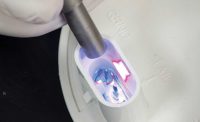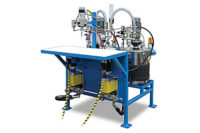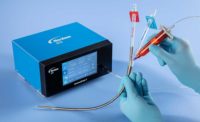Where and how a product is used can change significantly over time. Cyanoacrylate (CA) adhesives are a great example.
In 1942, Dr. Harry Coover was working as a chemist for Eastman Chemical Co. when he discovered the cyanoacrylate monomer. Coover created a CA formula and tested it as an extra-clear material for gun sights. Although the formula proved unsuitable for this purpose, Coover noticed that the monomers bonded quickly to various substrates and with incredible strength.
After further refinement over several years, Eastman introduced its first CA product (called #910) to the commercial market in 1958. Several years later, Loctite purchased some CA from Eastman and repackaged it as 404 Quick Set (which is still sold today). By the late 1970s, Loctite had become a major competitor to Eastman.
Looking to get into the CA market, the National Starch and Chemical Co. purchased Eastman’s business and merged it with several other acquired adhesive companies to form Permabond in 1978. Permabond LLC still produces the original #910 formulation.
Equally important, in the mid-1970s CAs became well known to the public as Krazy Glue because of the company’s famous commercial where the adhesive keeps a construction worker stuck to a high-rise steel beam indefinitely. Forty years later, manufacturers are still crazy about CAs and rely on them daily to bond plastic, metal, wood and glass substrates in many types of assemblies.
A Unique Adhesive
Unlike any other adhesive, CAs provide quick curing and high-strength bonding (more than 3,000 psi) to various substrates without the need for a separate heat or energy source. They also resist water and are available in a wide range of viscosities.
In recent years, suppliers have introduced new formulations of flexible CAs that also provide greater impact and heat resistance (up to 250 F). One supplier even makes a UV-cure CA that cures in 5 seconds.
CAs are one- or two-part adhesives consisting of base cyanoacrylate (or cyanoacetate) monomers and a proprietary blend of additives, stabilizers and fillers that affect viscosity, strength and curing speed. One of five types of monomers is used: methyl, for metal-to-metal applications; ethyl, for plastic, metal, wood, ceramics and glass substrates; isopropyl, for blended plastics such as polypropylene; or ethoxyethyl or methoxyethyl, for applications requiring no odor or bloom (white residue).
CA monomers polymerize rapidly in the presence of moisture on the substrate, although full cure can take several hours. The long polymer chains cross link to create a very strong bond between surfaces. Because humidity can also cause curing, the adhesive needs to be applied in thin layers. This ensures proper polymerization, curing and bonding in a reasonable time.
Low-viscosity (10 to 500 centipoise [cps]) CAs are often used in medical devices because they require wicking, or capillary action. In contrast, very viscous (6,000 to 9,000 cps) liquid or gel CAs are used to fill gaps greater than 0.01 inch.
Assemblers manually apply CAs from bottles (2 grams to 1 liter) in low-volume applications. The adhesive is dispensed automatically for high-precision or high-volume applications. Suppliers provide CA in containers up to 20 kilograms for dispensing systems.
CAs have a shelf life of 12 months when unopened and about one month once opened. However, they polymerize, become thicker and cure more slowly as they age. But, a CA can be thinned by mixing it with one of the same chemical composition but with lower viscosity.
“They are used in all sectors of manufacturing, from building cabinets for navy ships to the assembly of little toys,” claims Laurie Gibbons, business development manager for Permabond LLC. “As new products and industries develop, many are turning first to CAs for bonding.”
The Best Formulation
Manufacturers have two options when selecting a CA: Buy a standard brand or have the supplier make a custom formulation. Henkel Corp., which bought Loctite in 1997, manufactures a very wide range of standard CA formulations.
One is Loctite 3092, a two-part product (cyanoacrylate and curative) that is dispensed with a dual syringe. It bonds close-fitting (0.002-inch gap) plastic, rubber, leather and even paper substrates in 10 to 20 seconds.
John Lafond, product manager for instant adhesives at Henkel Corp., says automakers frequently use it to permanently secure heavy rubber or plastic exterior parts such as car mirrors and taillight lenses. Popular Mechanics named the adhesive a Best Car Technology Award winner at the 2012 Specialty Equipment Marketing Association convention.
The company’s 4902 and 4903 series were introduced earlier this year and are flexible CAs. They offer elongation up to 155 percent, compared to the typical 2 to 5 percent. Among other products, the adhesives have been used in medical devices and hovercraft.
Henkel’s Flashcure CAs cure in less than 5 seconds when exposed to low-intensity UV or visible light of the appropriate wavelength. These adhesives use photoinitiators to ensure surface cure in seconds. They also cure quickly at room temperature in shadowed areas.
Kitchen-cabinet and other woodworking manufacturers use the Nexabond 2500 series from Sirrus. The company makes three formulations that enable short (30 to 60 seconds), medium (2 to 4 minutes) and long (4 to 6 minutes) cure times, depending on the application.
Bob Blaut, director of sales for Sirrus, notes that the CAs can be used to bond wood to wood, plastic and medium-density fiberboard.
“In wood, there often isn’t much moisture present,” says Blaut. “But, there are sodium and potassium salts, and they initiate curing of our products, as does moisture. This unique capability allows the Nexabond series to bond to all wood species, even oily exotics.”
Sirrus also custom formulates CAs. One customer required an adhesive with a several-minute cure time to ensure first-in, first-out processing of assembled doors. Blaut says the adhesive has increased production by 30 to 40 percent.
Another industry that prefers CAs is lighting manufacturers. Matthew Ingerson, technical service analyst for RS Industrial, says fixture manufacturers use CAs because they withstand heat without deformation.
The company has custom formulated ethyl- and methyl-monomer-based CAs for more than 10 years. Recently, they introduced a series of CAs with a rubber additive. The rubber increases bond-area flexibility so it can better withstand impacts and freeze-thaw cycles.
RS also makes pre-engineered adhesive patches that fixture and properly orient substrates as the CA cures. Assembly Squares are 1 or more inches wide and 10 to 40 mils thick. Adhesive Squares are less than 1 inch wide and 12 to 50 mils thick. Ingerson says one medical manufacturer uses the squares when bonding bevels to specialty printers with CAs.
Adhesive Systems Inc.’s TS Series also contains rubber additives and comes in viscosities from 300 to 4,000 cps. It bonds similar and dissimilar surfaces, as well as those exposed to high stress, vibration, humidity and extreme temperatures (-65 to 250 F).
The company’s surface-insensitive (SI) CAs are ideal for substrates that are acidic, contain plasticizers or have low moisture. Clear in color, these ethyl-based adhesives set within 5 to 10 seconds and cure within 8 hours.
ASI also makes the RP series of general-purpose CAs. Their viscosity range is 5 to 4,000 cps; their strength range is 2,700 to 4,300 psi.
Some industries require colored CAs. Joseph Silvestro, executive vice president of Cyberbond LLC, says several manufacturers that assemble plastic parts have requested blue, green and tan CAs over the last two years. Because Cyberbond specializes in custom formulations, it is able to create these adhesives within 3 to 6 months.
The company also makes the Apollo series of more than 30 CAs. Xtraflex 2240 is a rubber-toughened, partly flexible adhesive that bonds rubber, metal and plastic substrates in harsh environments and temperatures (-65 to 280 F).
“Manufacturers expect consistent quality in every bottle of CAs,” says Silvestro. “It requires proper quality control of all raw materials, including stabilizers and additives. Above all, the cyanoacetate must be pure and properly processed.”
California-based Pacer Technology makes a wide range of standard and advanced-grade CAs. Its customer base is industrial and consumer, along with niche industries like sporting goods manufacturing. Custom-formulated CAs also are available.
The supplier’s RX (range-extended) series are surface-insensitive and formulated to bond porous substrates and those contaminated with grease, oil or a release agent. It works on metals, plastics, vinyl, nylon and woven fabrics, and fills gaps from 0.002 to 0.02 inch. Viscosity ranges from 5 to 2,500 cps.
Gibbons says electronics manufacturers prefer CAs for many applications. One is chip assembly on dual-sided PCBs prior to wave soldering. This process requires a CA that can resist extremely high temperatures. Permabond 820 withstands temperatures up to 390 F and has a viscosity of 100 cps.
The Scotch-Weld EC series from 3M features low, medium and high-viscosity liquids and an industrial-strength thixotropic gel (ECI) of 7,000 to 20,000 cps. They bond to most plastics, rubbers and metals and have a tensile strength of 2,900 psi. EC40 is recommended for smooth surfaces and EC2500 for rough or porous ones. Other products include EC100 (general purpose) and EC600 (wire tacking on PCBs).
Useful Innovation
Manufacturers also love CAs because they do more than just bond substrates. For example, slow curing enables them to be used for temporary fixturing. George Ritter, Ph.D., principal engineer for the Edison Welding Institute, says this fixturing allows sequential assembly while minimizing the time the joint is susceptible to being disturbed as the adhesive sets.
Specialty glass manufacturers often fixture many layers of glass to expedite their cutting, notes Gibbons. The cut stacks are then soaked in acetone to remove the adhesive.
She says that one furniture manufacturer bonds large sections of polycarbonate to wood with a slow-curing structural adhesive, and then fixtures these sections with CA so they can be easily moved out of the production area while the structural adhesive cures.
Gibbons says manufacturers also use CAs to improve the durability of prototypes made with 3D printing. After the prototype is de-powdered, it is dipped into a CA bath for a few seconds and removed. Gibbons says the CA wicks into the porous model and improves hardness. Within a minute, the model is dry to the touch.
Permabond 940 is used in this process. The CA is odor-free for a comfortable working environment. It also is used by cosmetics manufacturers to prevent blooming on black plastic packaging.
“Hybrid one-part CAs could be the next major development,” concludes Lafond. “They would offer the structural capability of epoxy, along with optimum heat resistance, toughness, curing speed and ease of use. That would be nirvana.”
ASSEMBLY ONLINE
For more information on cyanoacrylates, visit www.assemblymag.com to read these articles:








